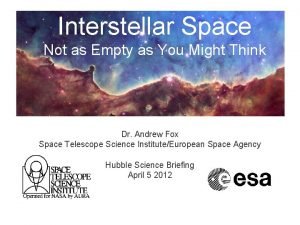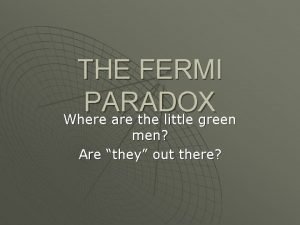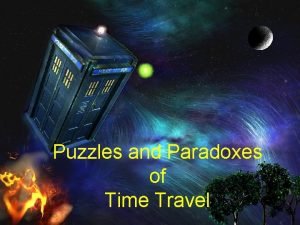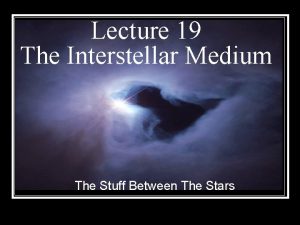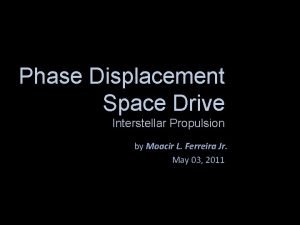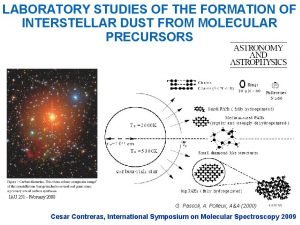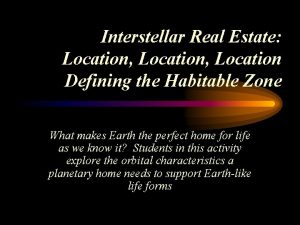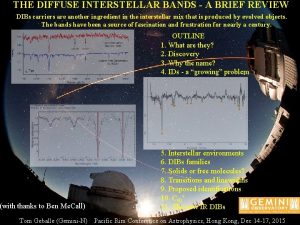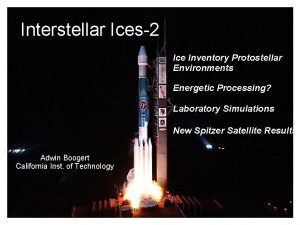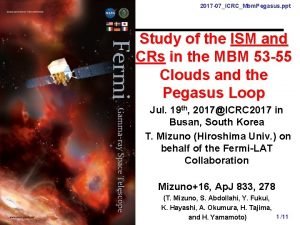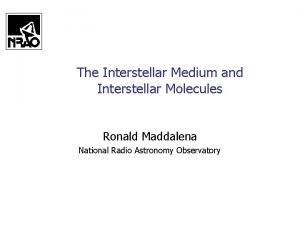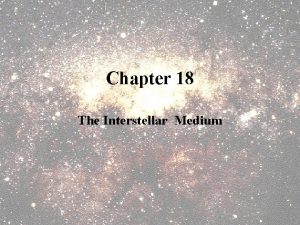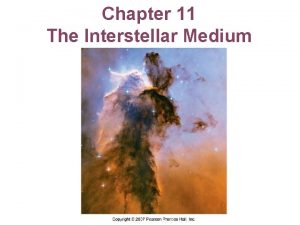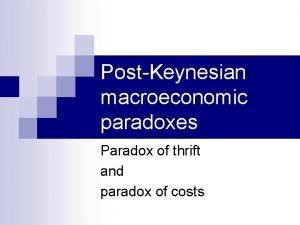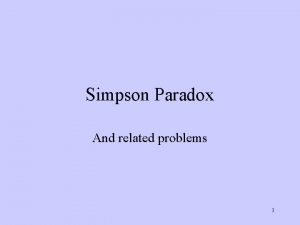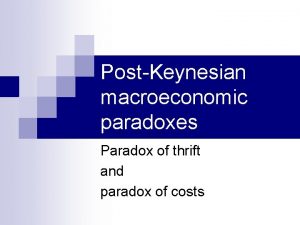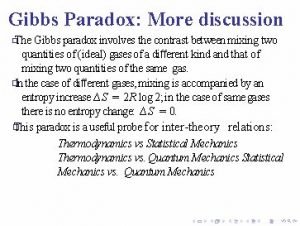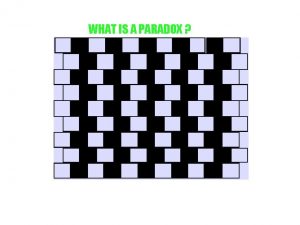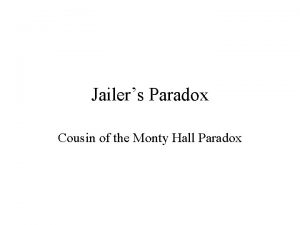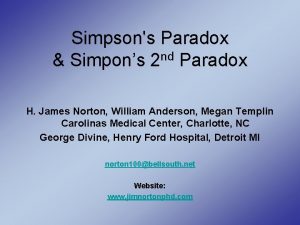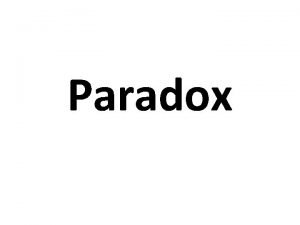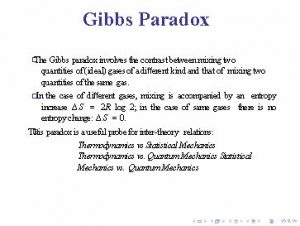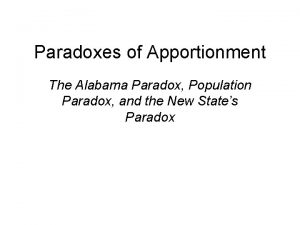Interstellar Travel and the Fermi Paradox So where































- Slides: 31

Interstellar Travel and the Fermi Paradox “So where is everyone? ”

People or Photons? • People have mass and that requires enormous amounts of energy to accelerate. • People have needs (food, water, air, etc) which means more mass to transport! How much mass person to take? • Space ships travel very slowly • Photons are mass-less and travel at the speed of light!

Current spaceship technology • Spacecraft travel at speeds much less than 100, 000 km per hour • At this speed, travel to the nearest star would take 46, 500 years!

Space Travel • (12) Humans have gone to the Moon • Machines have traveled in our Solar System out to Neptune and en route as we speak to Pluto • As a species we have the urge to explore and colonize.

Challenges to travel to the stars • Distances involved are enormous and will take us time to traverse • The energy requirements are equally immense and very difficult to satisfy (even if we are willing to pay the price).

Power for the trip • Chemical combustion is our current form of energy in rockets … very inefficient. • Solar power works well near stars but is also inefficient • Nuclear power for both on-board power (to live, etc) as well as thrust is possible with our technology. • Matter and anti-matter … more efficient certainly but also beyond our means at present.

Exotic power • Interstellar Ramjets … • Ion propulsion … prototypes already tested. • Warp drive … dilithiunm crystals anyone?


Time Dilation • As you travel faster, your own clock (in your frame of reference) slows down from an outside perspective. • Traveling at a significant fraction of the speed of light means you experience a smaller passage of time compared to an Earth based observer

Relativity • T = T 0 / Sqrt (1 –v 2/c 2) • where T 0 is the time elapsed in the moving frame of reference • where T is the time elapsed in the stationary frame of reference • where v is the speed you are moving relative to the stationary observer.

A solution? Perhaps traveling at high speed will allow people to survive interstellar treks.

Time dilation example • You and your friend synchronize your watches. • You remain on Earth and your fired ‘flies off’ at 99% the speed of light. • Your friend returns when 1 hour of time has elapsed according to their watch. • You have waited approximately 7 hours for your friend to have returned!

One more danger. . • At higher speeds for our spacecraft, the particles in the ISM are now moving at enormous velocities relative to you. • If your spaceship is moving at 99% the speed of light, the kinetic energy of a particle in the ISM will seem like a very energetic bullet and could do serious damage to the spacecraft … shields anyone? !

Enrico Fermi 1901 -1954

The Fermi Paradox • The belief that the universe contains many technologically advanced civilizations, combined with our lack of observational evidence to support that view, is inconsistent. Either this assumption is incorrect (and technologically advanced intelligent life is much rarer than we believe), our current observations are incomplete (and we simply have not detected them yet), or our search methodologies are flawed (we are not searching for the correct indicators).

Logic … • We are not special in our development (life on Earth) • Thus via the Drake Equation, life should be relatively common in the Milky Way. • Even traveling at slow speeds, colonization should have lead to outposts everywhere by now. (Milky Way is 10 billion years old. )

Even worse … Von Neuman machines • Build self replicating machines and let them explore the galaxy. • In this way, while colonization is not performed, the presence of civilizations would be felt everywhere in the galaxy. • Probes are not encumbered by the physical limitations of life (air, water, aging etc. ). Relatively easy to produce.

An aside … • Von Neuman machines might consume all the resources in a galaxy! (They could develop exponentially. ) • If so, any civilization capable of producing these machines would not!

The contradiction • Colonization should have occurred • No evidence of such rampant colonization

Solution #1 • We are the first technologically advanced civilization capable of interstellar travel and communication. • If so, SETI is a waste of time … no one out there to talk to. • This solution sounds much like the Geocentric Model of the Solar System … Earth special (unique, rare) and does not seem likely. Nothing in astronomy or biology suggests we are special.

Cosmic Calendar (inspired by Carl Sagan) • Imagine the age of the universe (and thus life on Earth) compressed to 1 calendar year. • January to November inclusive. Each month is 1 billion years, each second is 390 years. March August November

December ….

To note … • The dinosaurs existed from December 25 through 30! • The entire human history is less than 30 seconds long (~10, 000 years)! • Planets capable of harboring life in our galaxy could have formed in July! • Almost any assumptions you make result in a conclusion that civilizations have had ample time to form and develop and colonize

Comparable age and development? • Perhaps a more useful question to ask is ‘Are other civilizations technologically comparable to us? ’ • We have had space travel and interstellar communication capability a short time. How long will we keep it? • More likely other civilizations very advanced or very inferior technologically speaking.

Colonization • Like the Von Neuman machines, interstellar colonization would result in the relatively rapid spread of settlements throughout the Milky Way galaxy. The coral model. • Note that colonization does not represent a solution to the population explosion on a planet (like Earth).

Human Population • Humanity is experiencing an exponentially growing population which is, arguably, unsustainable. • Approximately 100 million people born annually.

Why colonize? • Assuming the attitudes associated with life on Earth are not unique, then our history is resplendent in voyagers of exploration and colonization • Other civilizations may colonize to avoid their culture becoming extinct (existing on more than one planet). • Perhaps colonization is spurred on by the need to flee persecution, etc.

Other solutions to the Fermi Paradox: Solution #2 • Civilizations common but have not colonized the galaxy. – TECHNICALLY TOO DIFICULT (OR TOO EXPENSIVE IN TIME AND ENERGY) – THE DESIRE TO COLONIZE IS NOT COMMON (WE ARE ATYPICAL) – DESTRUCTION OF THE CIVILIZATION OCCURS BY THEMSELVES OR THROUGH NATURAL CAUSES (ASTEROIDS, ETC. )

Other solutions to the Fermi Paradox: Solution #3 • There is a galactic civilization out there and they have chosen to keep us isolated (Star Trek’s Prime Directive). Thus there is no paradox! • Sometimes called the Zoo hypothesis … but we may still yet detect their signals even if they choose not to communicate with us. • Time likely needed for SETI to succeed.

Other solutions to the Fermi Paradox: Solution #3 cont. • The Sentinel hypothesis suggests that galactic civilizations are indeed monitoring us, waiting for us to reach the right level of technology … allowing us to join the Galactic Club.

Too expensive? • It often comes down to money … • ‘It is fine to argue about the number of civilizations that may exist. After the argument, there is no easy substitute for a real search out there … we owe the issue more than mere theorizing. ’ … Philip Morrison • Answering the Fermi Paradox will arguable be a turning point in our history.
 What is interstellar travel
What is interstellar travel The fermi paradox – little green men
The fermi paradox – little green men Time travel puzzles
Time travel puzzles What is the interstellar medium
What is the interstellar medium Interstellar
Interstellar Interstellar google drive
Interstellar google drive Interstellar isabella
Interstellar isabella Interstellar
Interstellar Interstellar realty
Interstellar realty Diffuse interstellar bands
Diffuse interstellar bands Interstellar
Interstellar Diffuse identity
Diffuse identity Diffuse interstellar bands
Diffuse interstellar bands Interstellar
Interstellar Interstellar medium ppt
Interstellar medium ppt Hình ảnh bộ gõ cơ thể búng tay
Hình ảnh bộ gõ cơ thể búng tay Lp html
Lp html Bổ thể
Bổ thể Tỉ lệ cơ thể trẻ em
Tỉ lệ cơ thể trẻ em Voi kéo gỗ như thế nào
Voi kéo gỗ như thế nào Tư thế worms-breton
Tư thế worms-breton Bài hát chúa yêu trần thế alleluia
Bài hát chúa yêu trần thế alleluia Các môn thể thao bắt đầu bằng từ đua
Các môn thể thao bắt đầu bằng từ đua Thế nào là hệ số cao nhất
Thế nào là hệ số cao nhất Các châu lục và đại dương trên thế giới
Các châu lục và đại dương trên thế giới Công thức tính độ biến thiên đông lượng
Công thức tính độ biến thiên đông lượng Trời xanh đây là của chúng ta thể thơ
Trời xanh đây là của chúng ta thể thơ Mật thư tọa độ 5x5
Mật thư tọa độ 5x5 Làm thế nào để 102-1=99
Làm thế nào để 102-1=99 độ dài liên kết
độ dài liên kết Các châu lục và đại dương trên thế giới
Các châu lục và đại dương trên thế giới Thể thơ truyền thống
Thể thơ truyền thống
